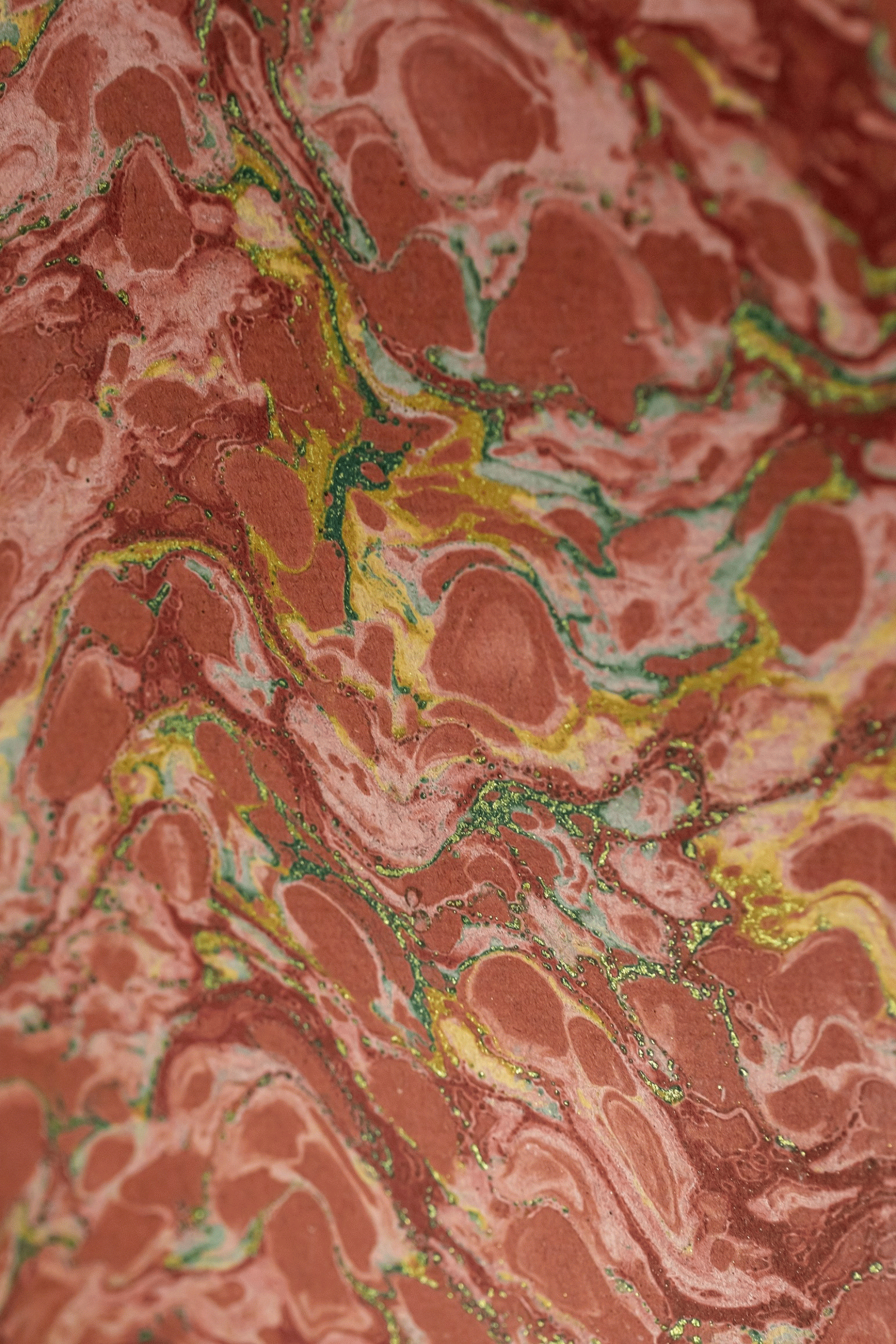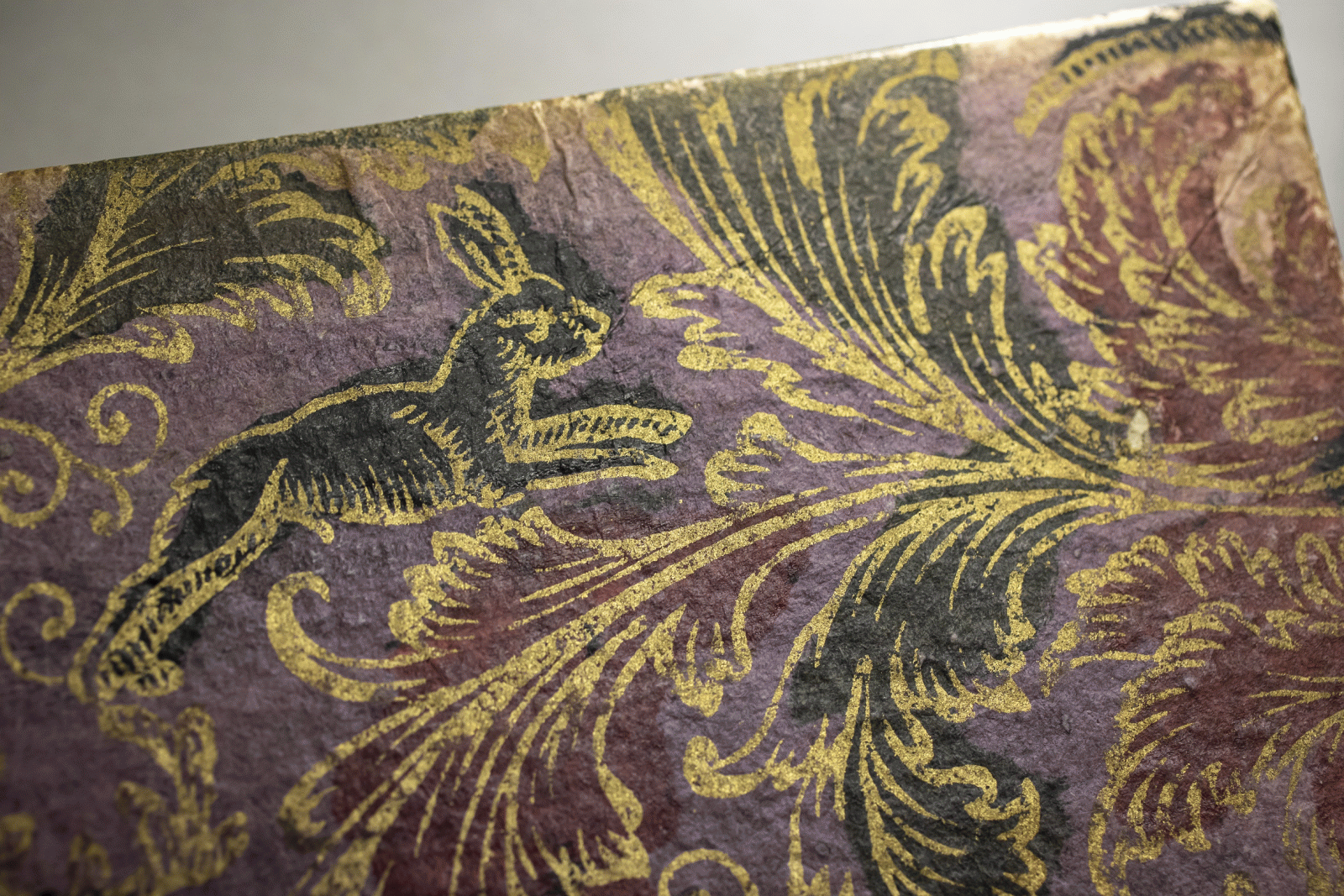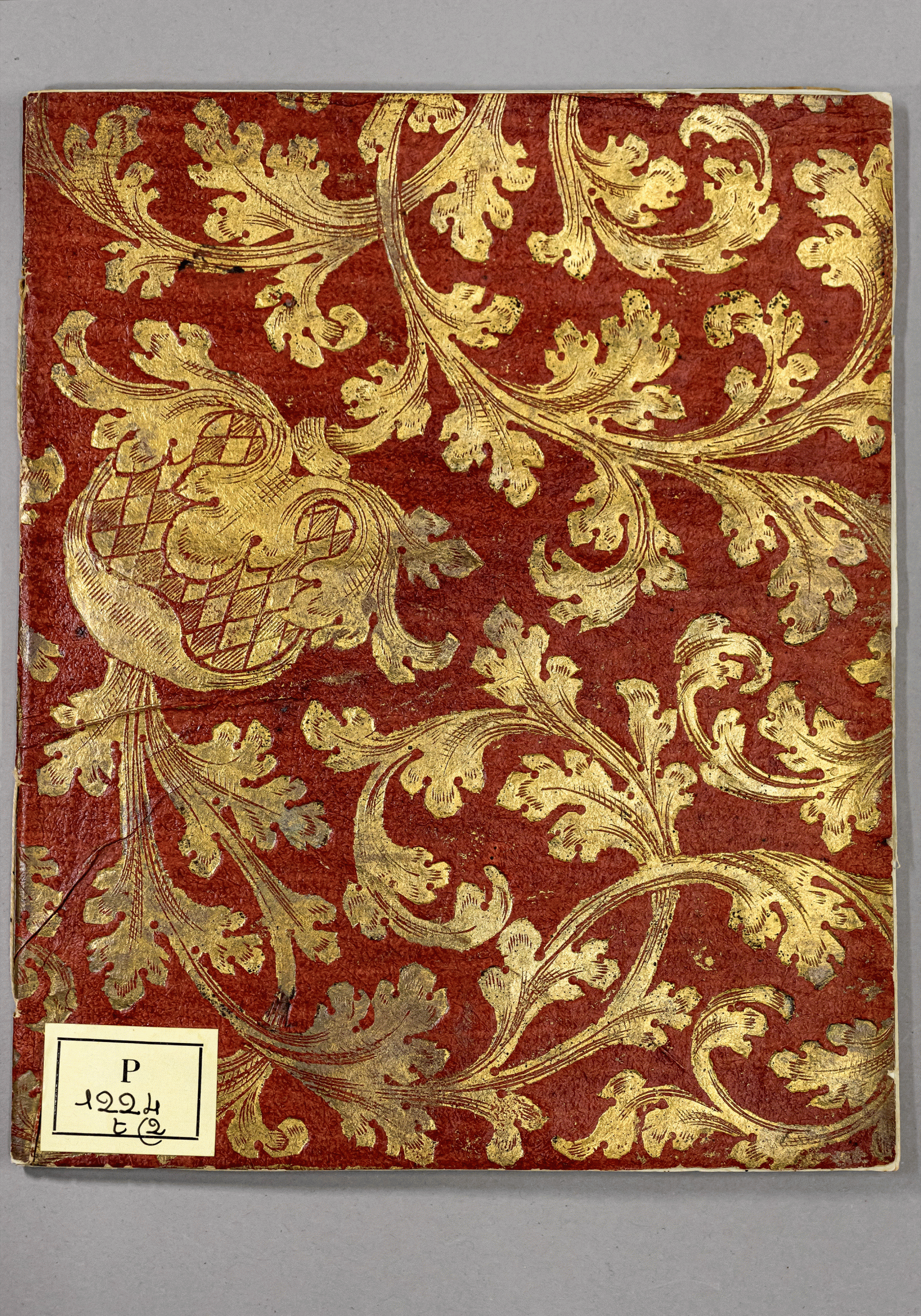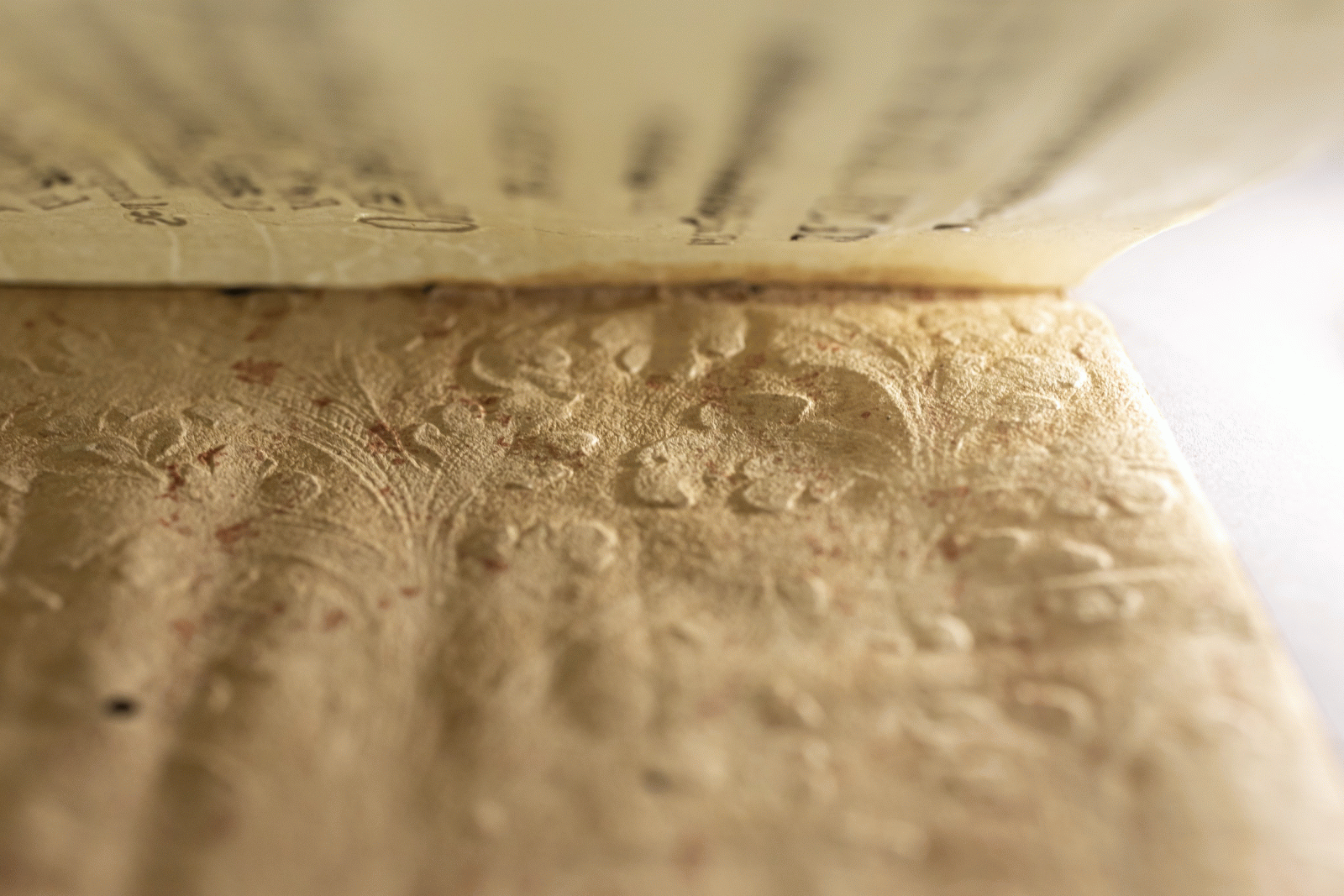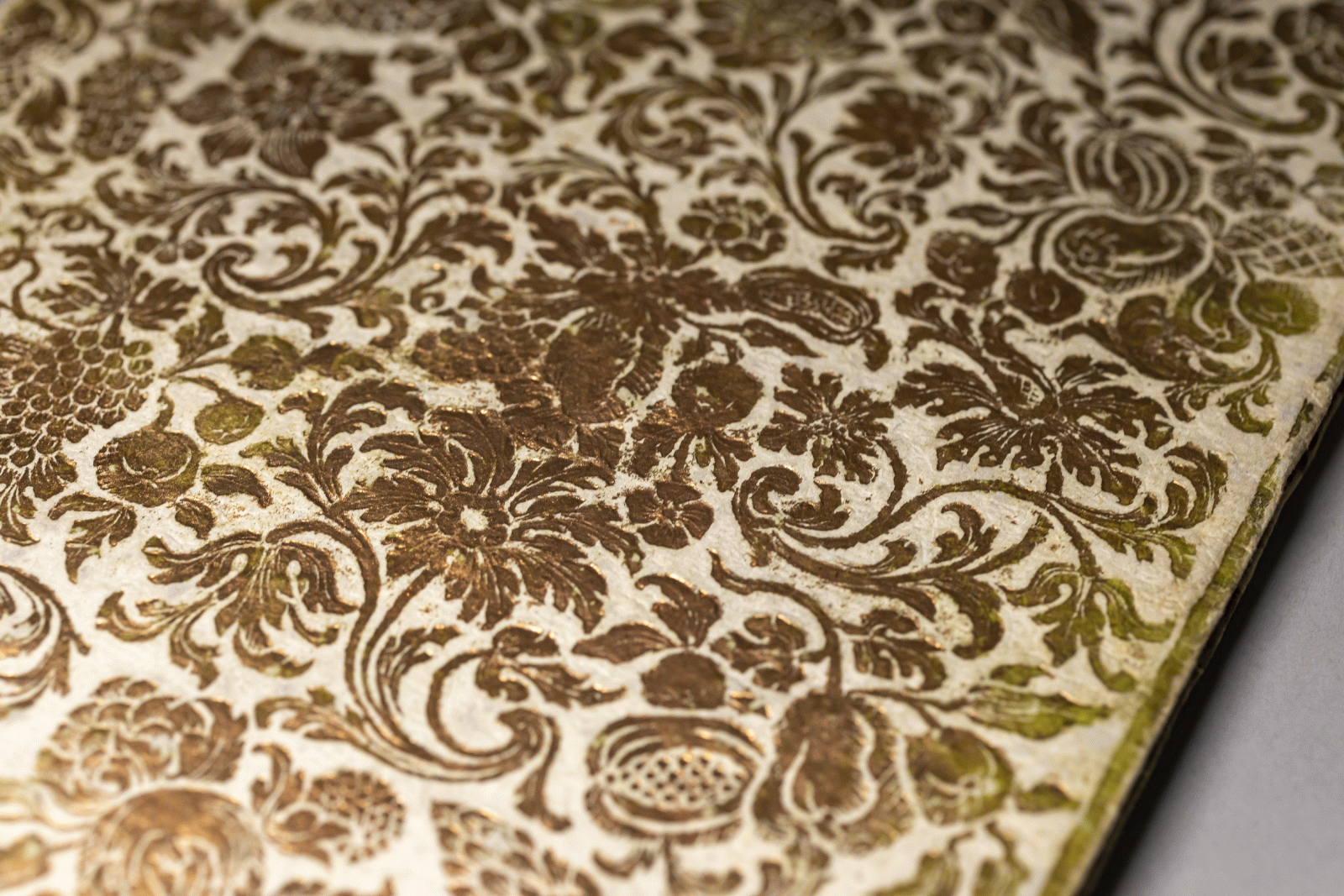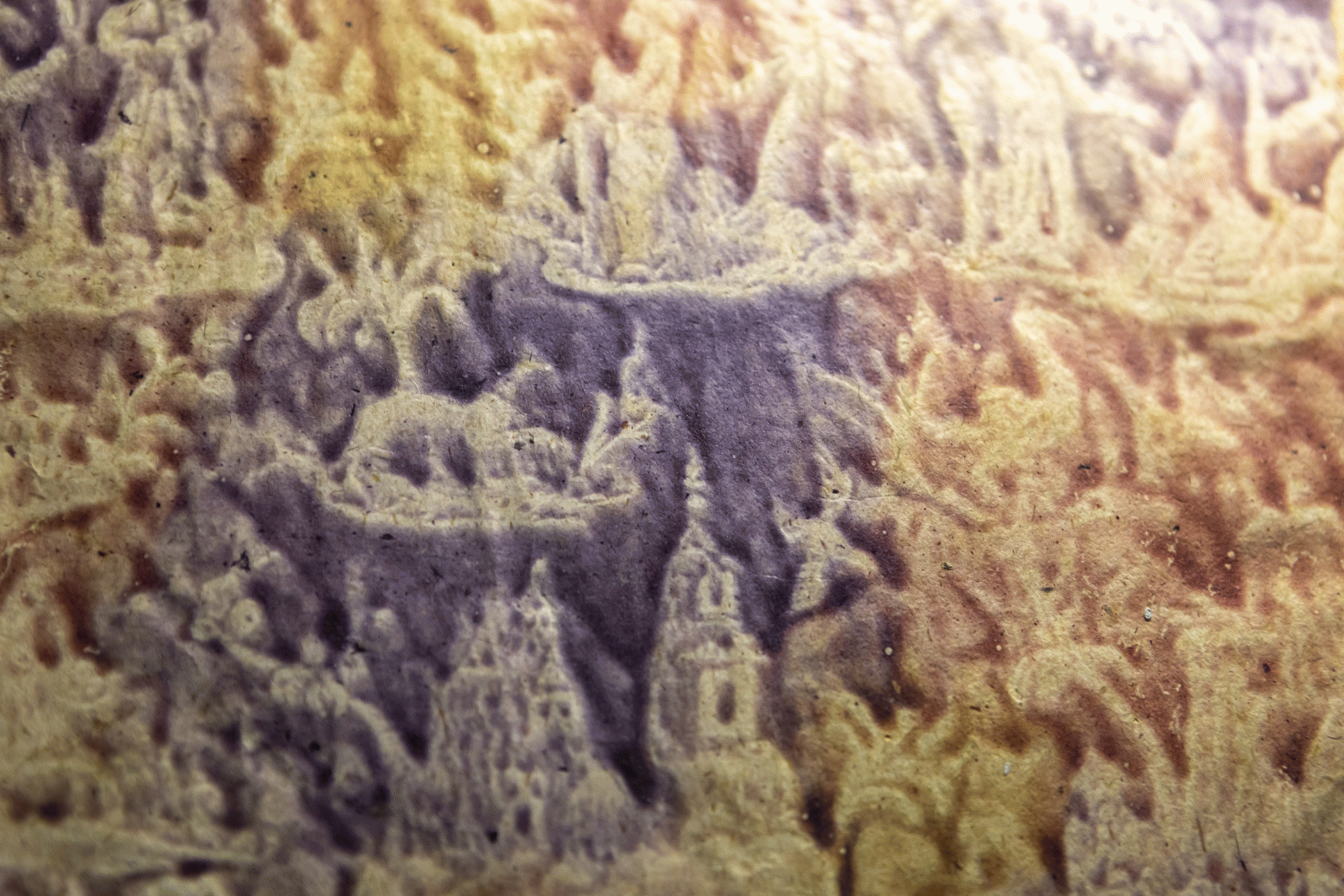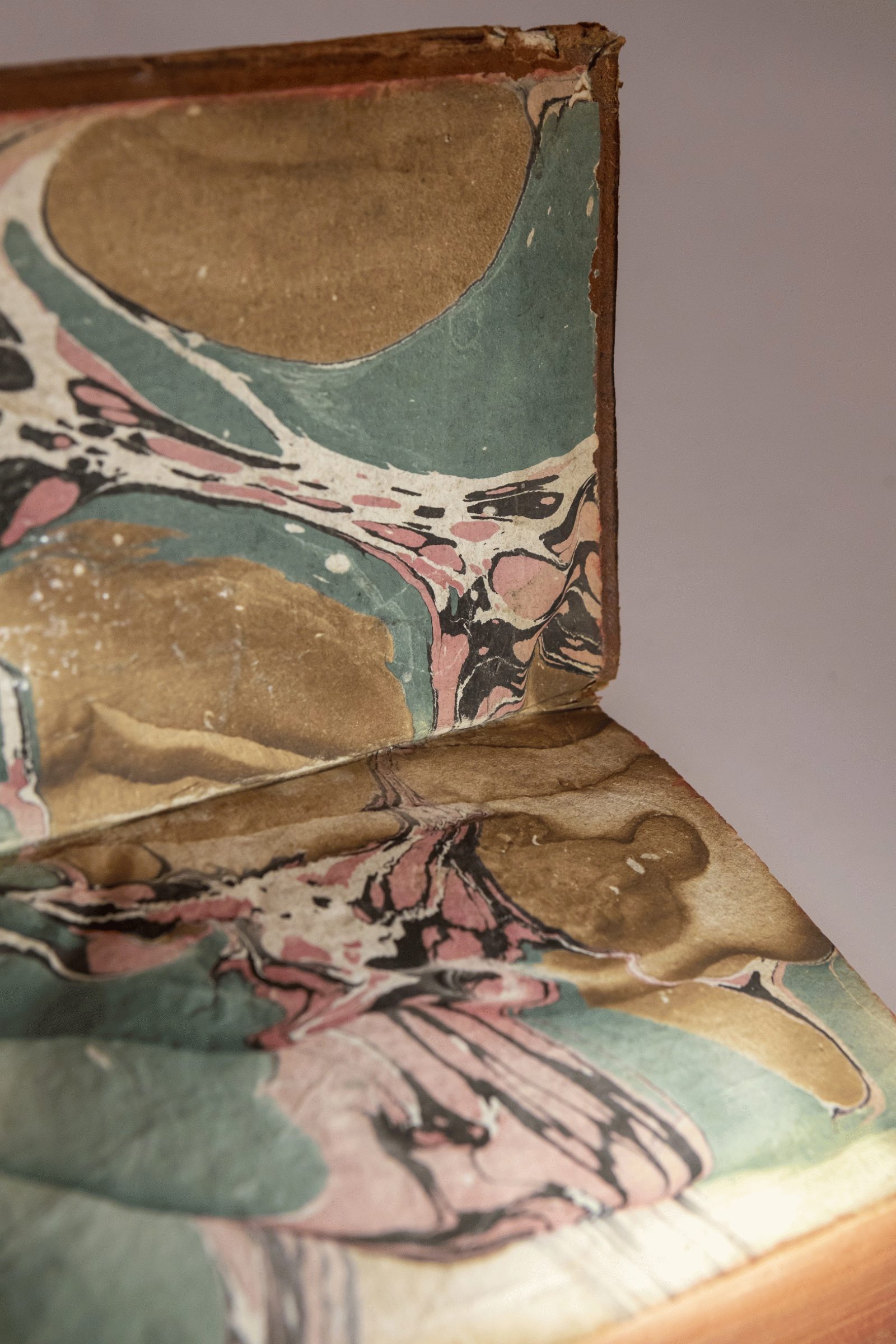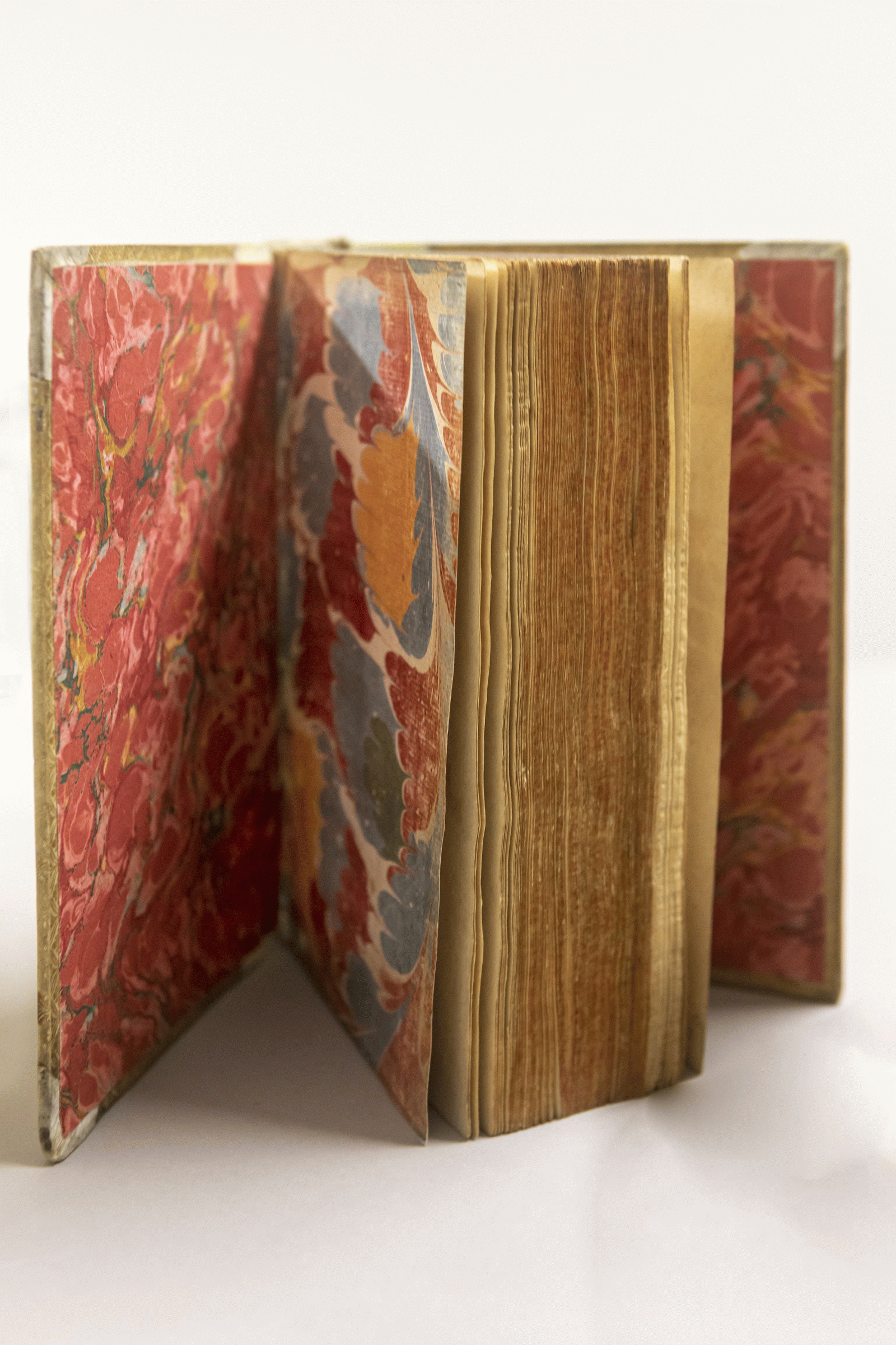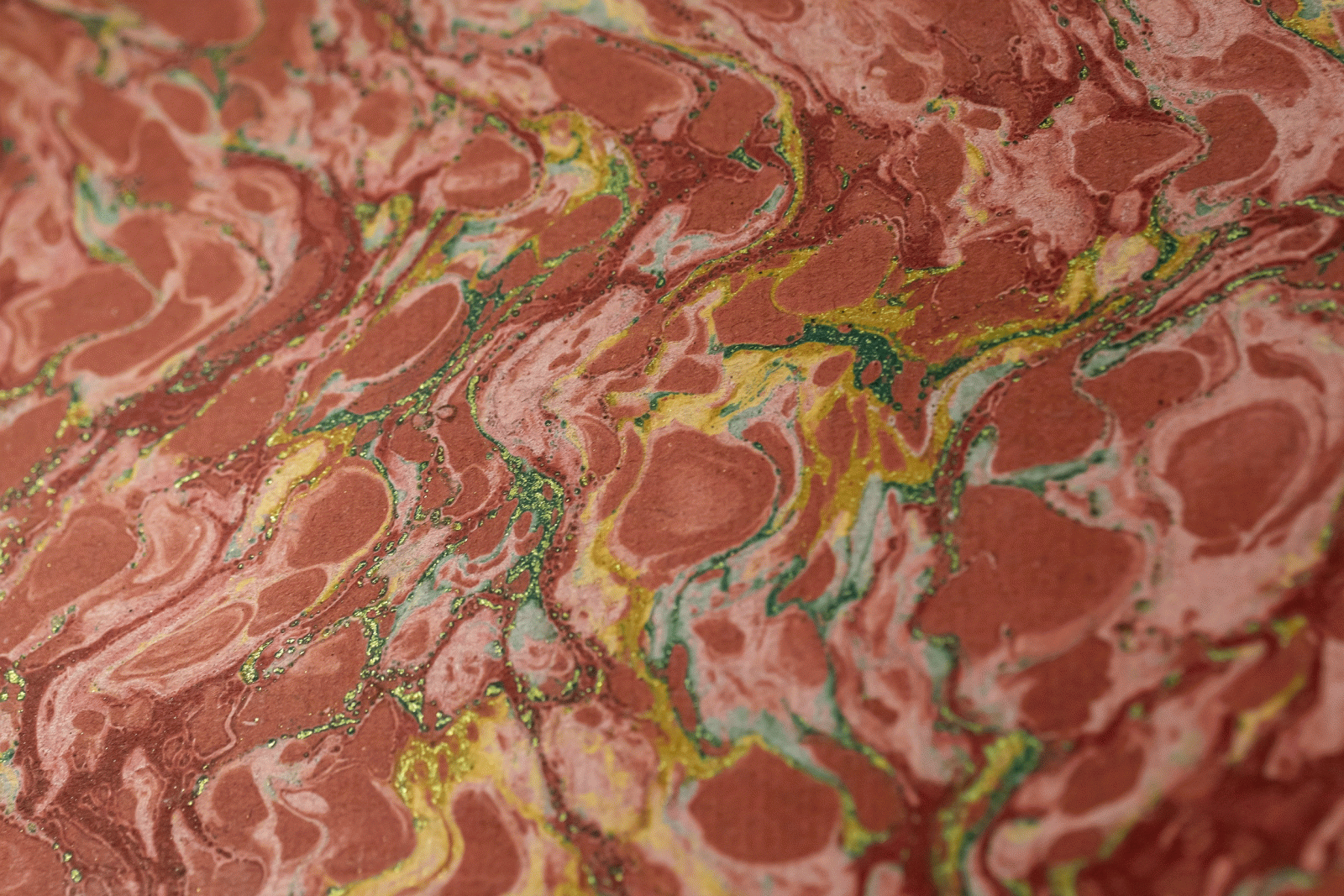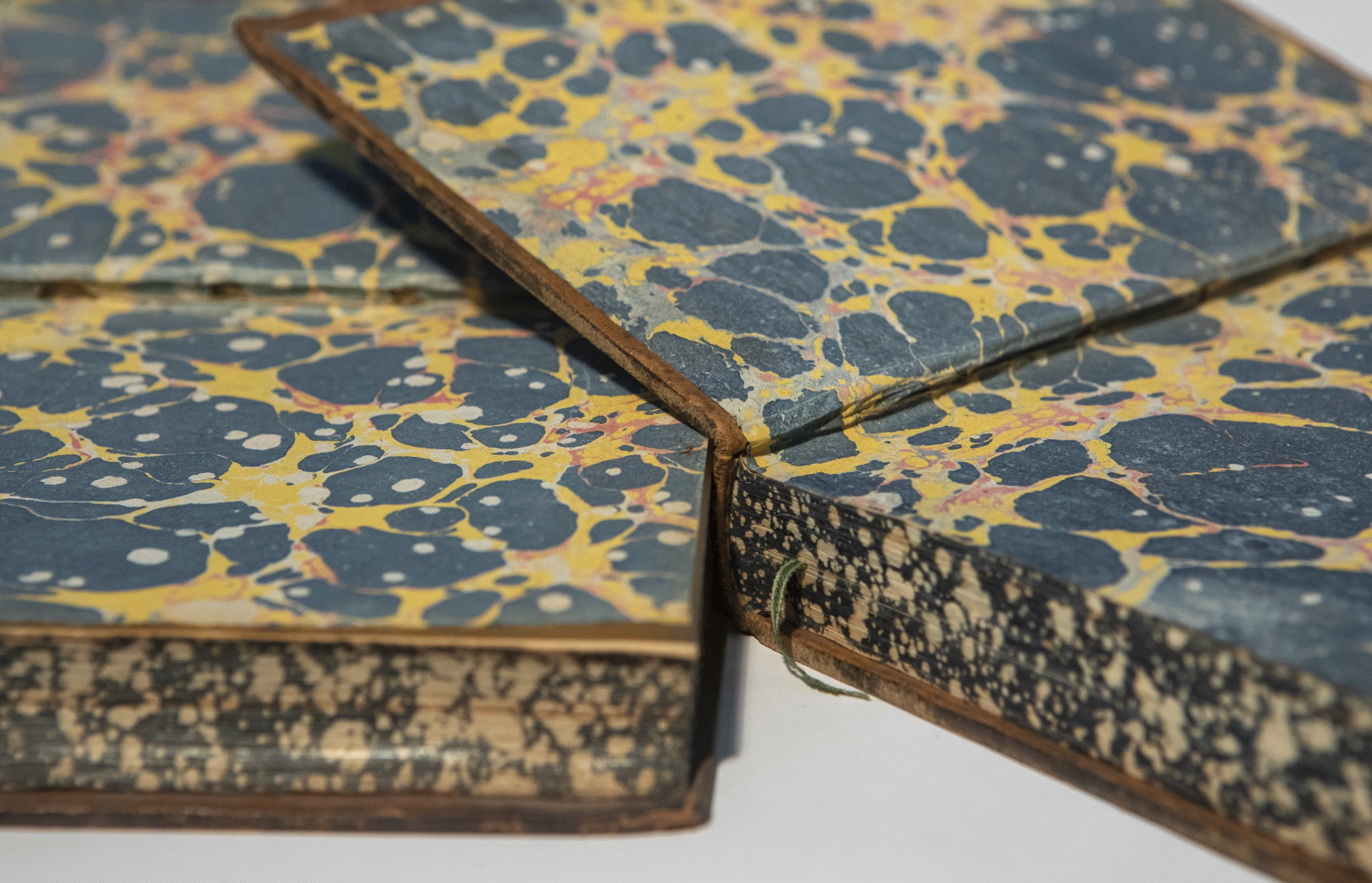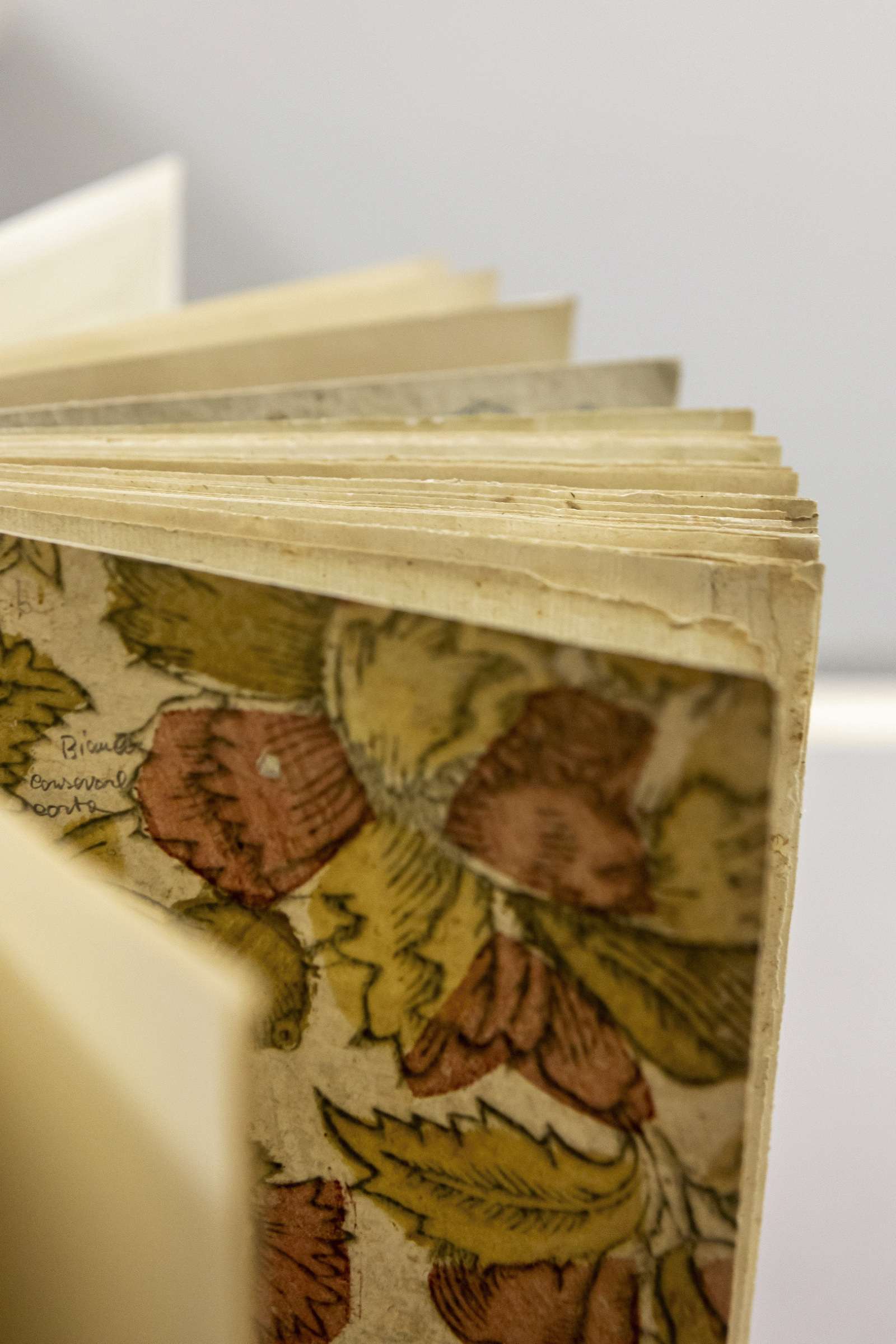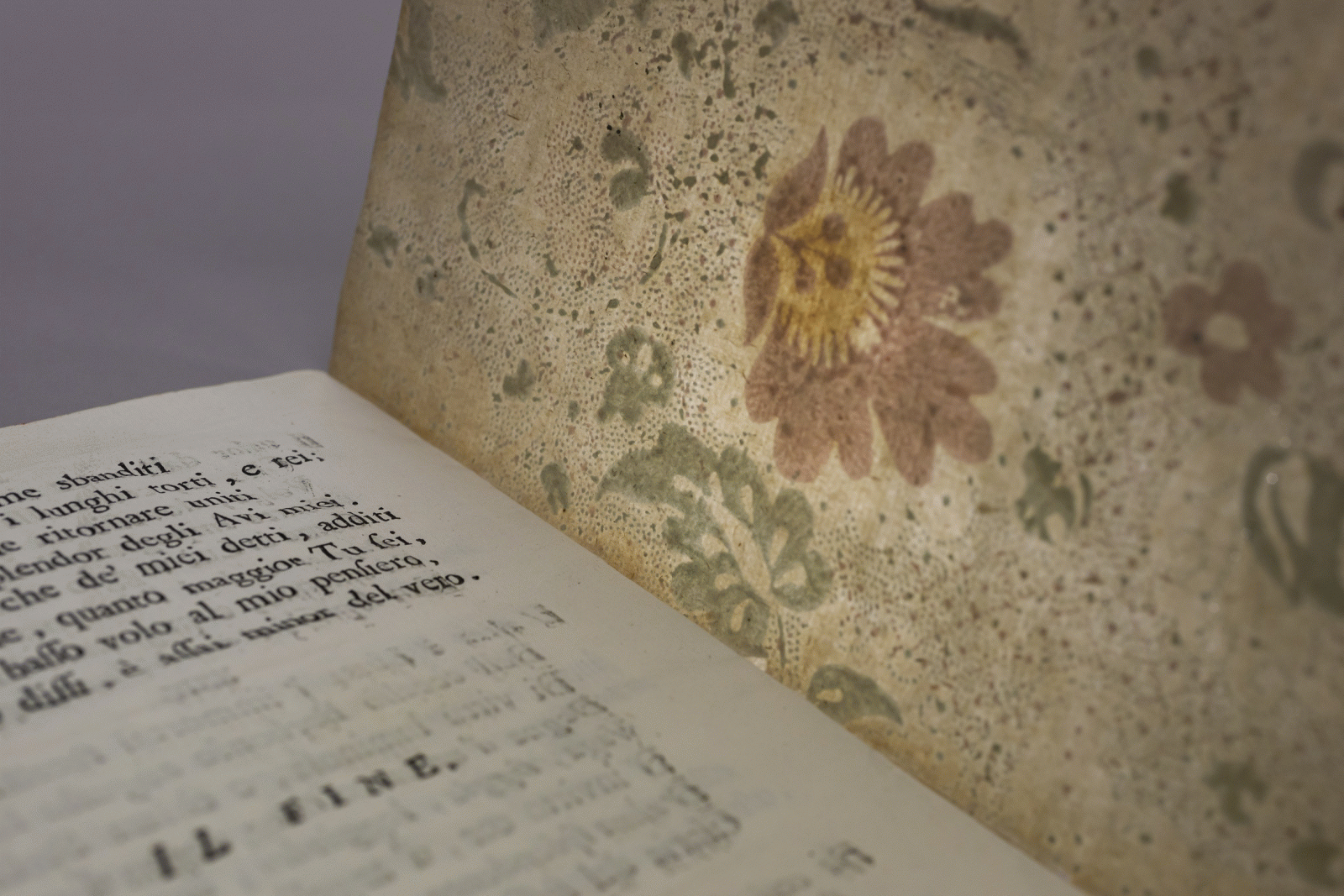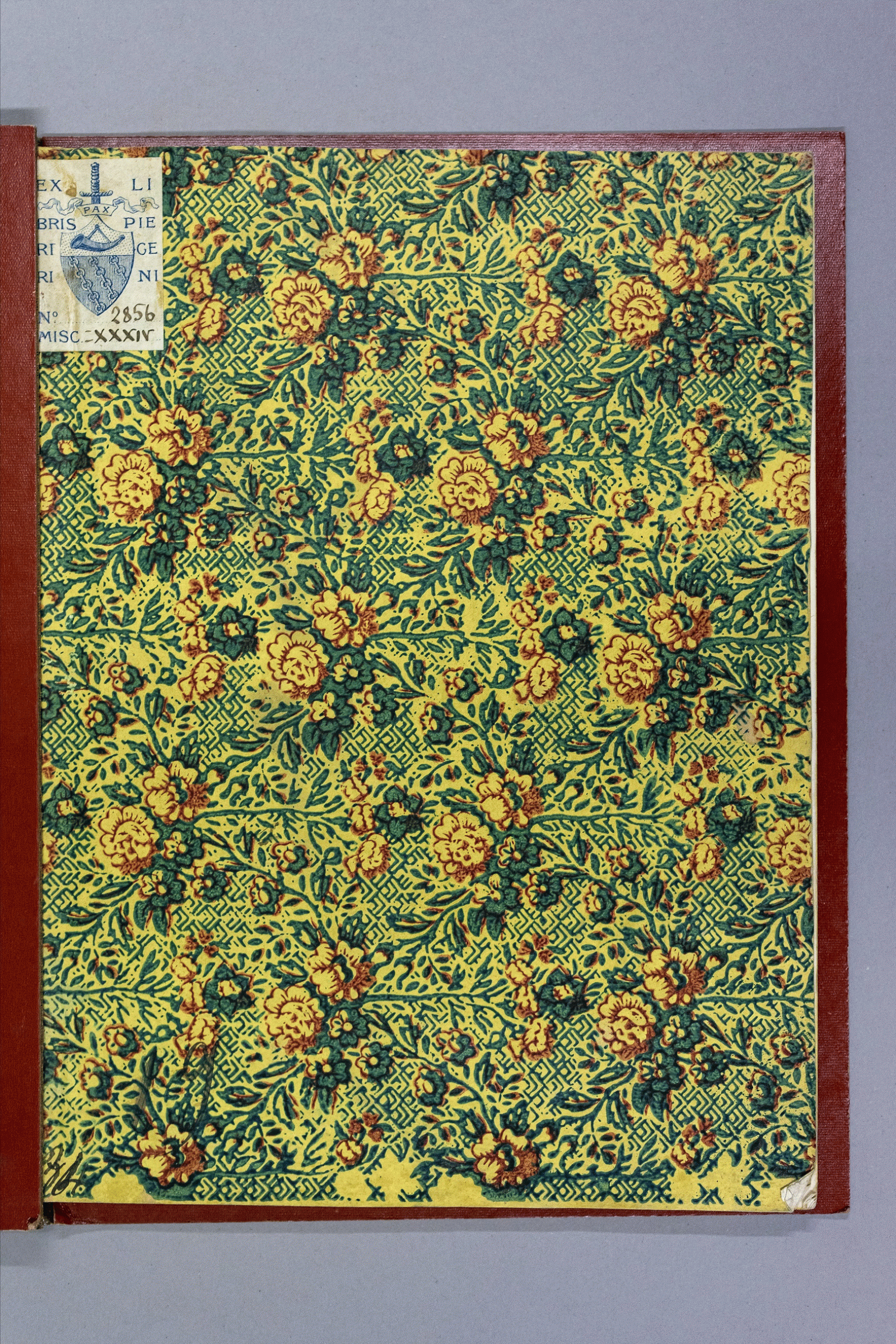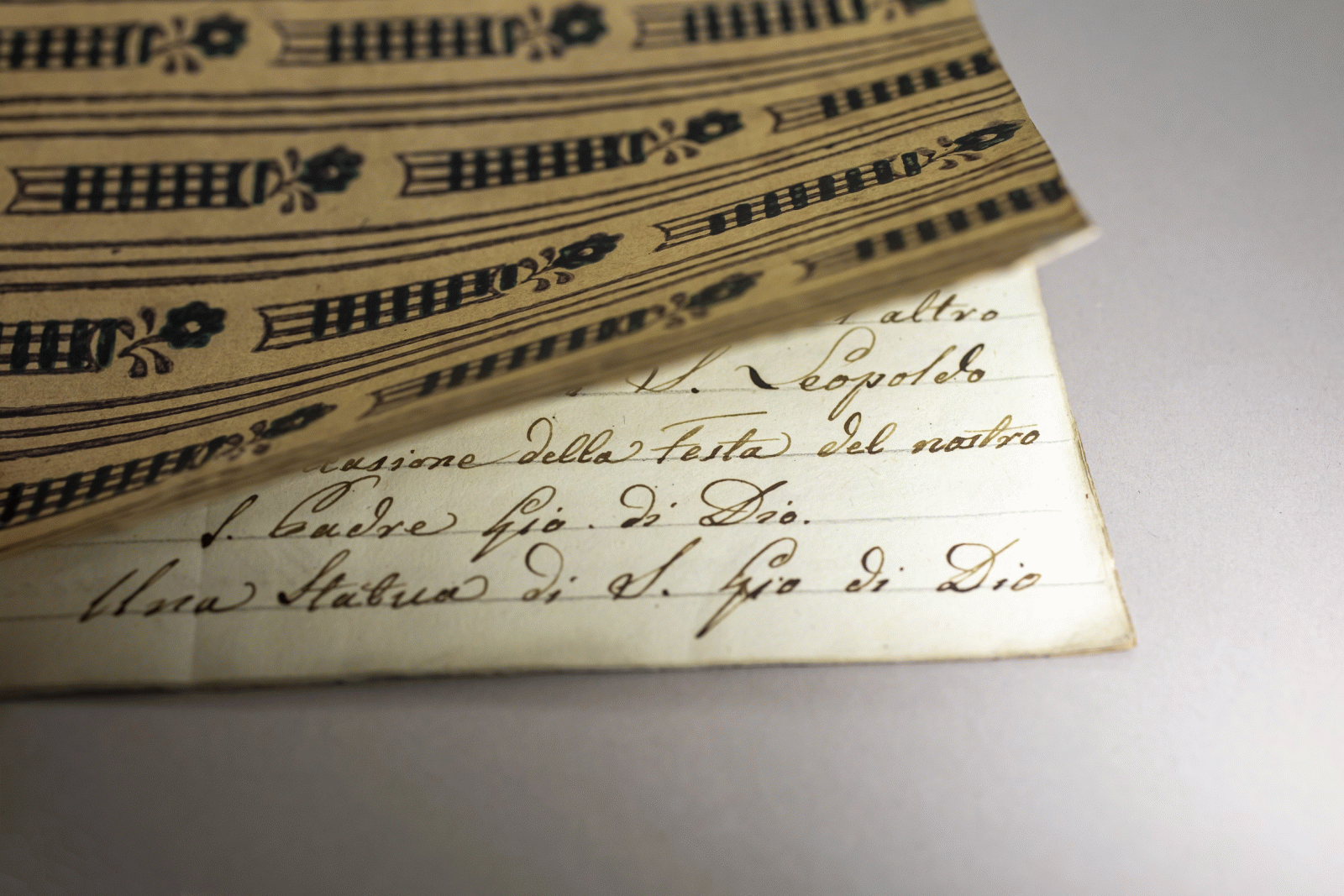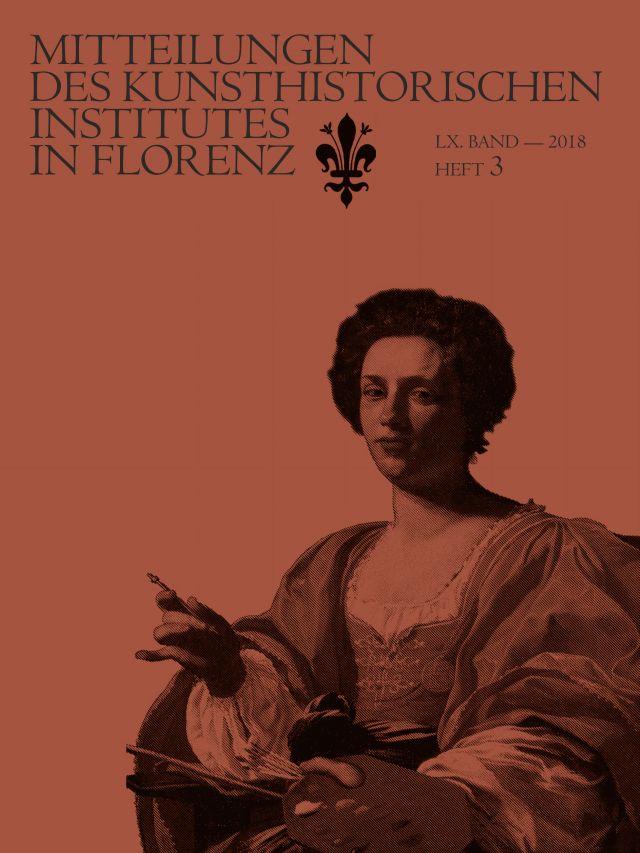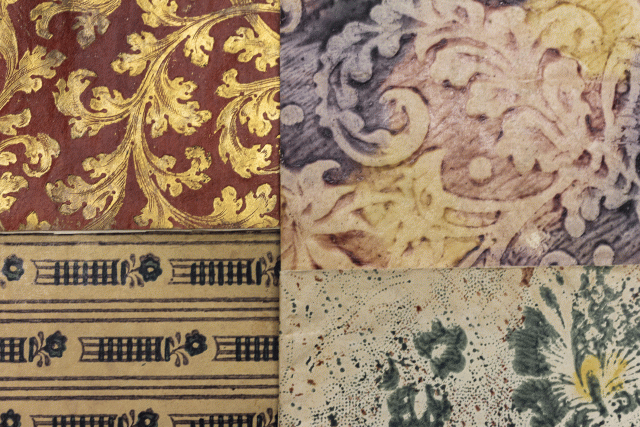When antiquarian books are acquired by the library, they often come decorated with a variety of papers coloured using different techniques.
Particularly attractive are the gilded and brocade (gold embossed) papers which were produced from the late 17th to the end of the 18th century, chiefly in southern Germany, and even exported overseas. The library has some covers of brochures, occasional prints and books as well as endpapers of this type (see Garzadoro 1675, Mariscotti 1717, La distribuzione dei premj 1806).
Less precious and preserved in greater numbers are the brightly coloured paste papers of the 18th century. Of particular interest are two examples of blind printing, which is when the dabbed-on paste colour (while still wet) is moved onto a printing plate without ink, thus revealing a tendril pattern (Lettera di ragguaglio 1731) and small-scale chinoiserie (Soldani 1751).
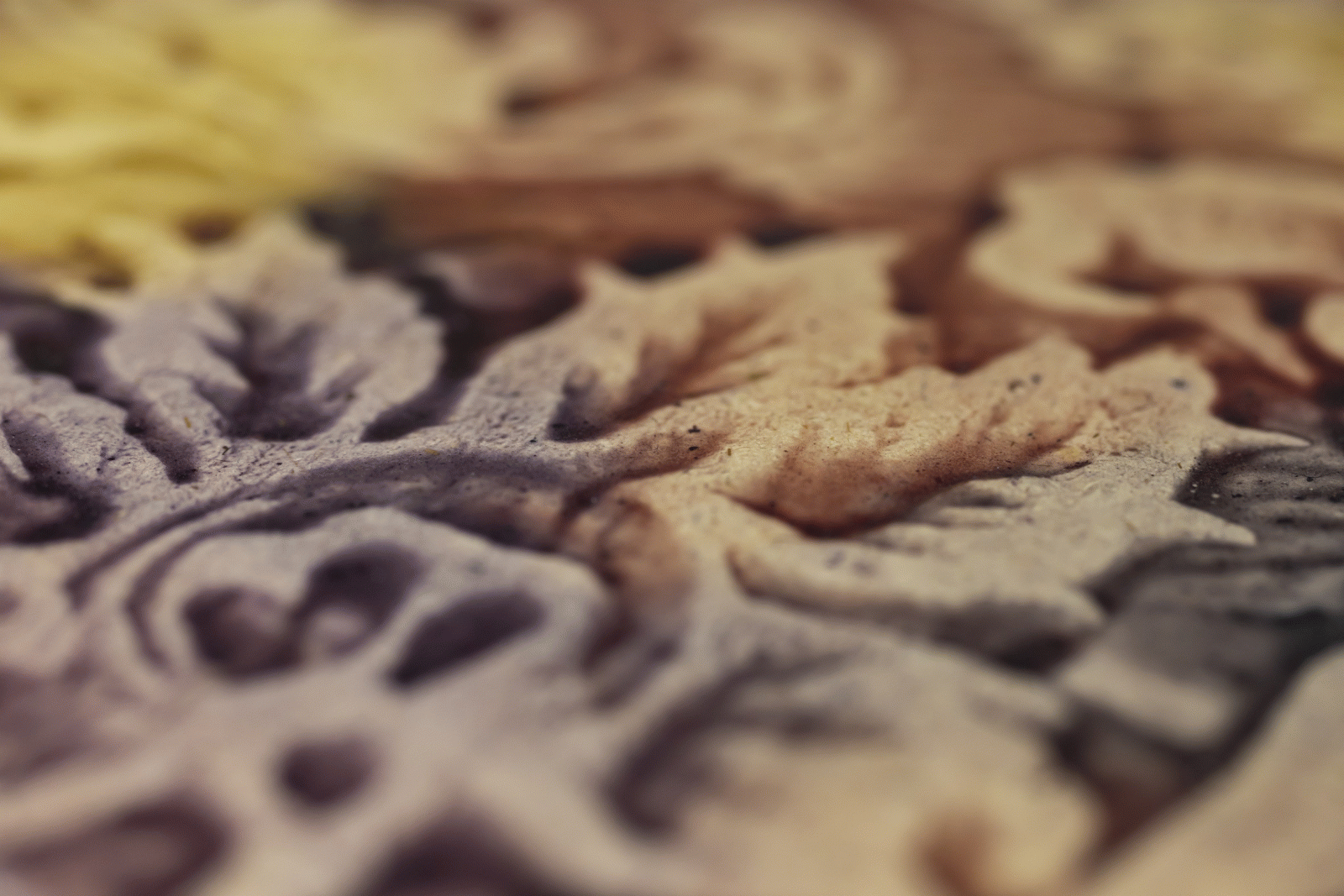
Veined paste paper with displacement-decoration (blind print), tendrils and blossoms, 18th century.
Lettera di ragguaglio scritta ad un amico dell’arrivo, e feste fatte in Siena all’eminentissimo sig. cardinale Vincenzo Bichi, Siena 1731.
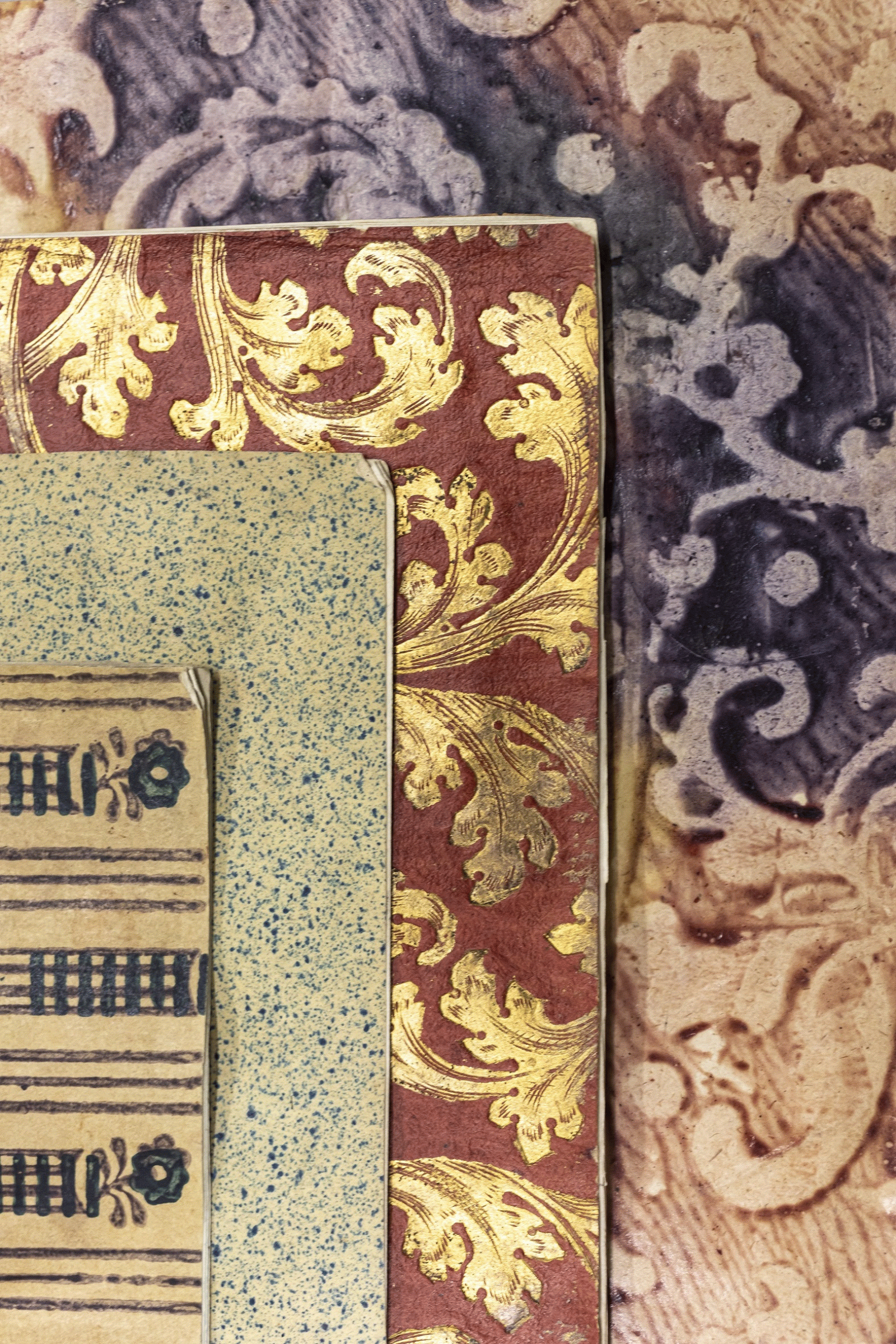
Inventario del Convento di S’Antonio Ab.e di Livorno 1839-1840.
Dionisio Mariscotti, Applauso festivo del possesso dall’A.R. della Serenissima Violante, gran principessa di Toscana […], Siena 1717.
Lettera di ragguaglio scritta ad un amico dell’arrivo, e feste fatte in Siena all’eminentissimo sig. cardinale Vincenzo Bichi, Siena 1731.
Marbled papers in various patterns (combed marble, stone marble, bouquet marble, etc.) have been popular since the 17th century. Many examples are preserved in the library (de Arce y Cacho 1786, Scannelli 1657, Interián de Ayala 1782). As with paste papers, the result of the manufacturing process cannot be planned down to the last detail. The result is therefore always unique. The cut of the book by Juan Interián de Ayala (1782) is colour-coordinated with the blue-yellow stone marble paper of the flyleaf. Presumably, dripped wax, which flaked off after drying and opening the cut, formed the irregular spots that remained white after colouring the cut.
Calico papers (model prints) were very popular – they were inspired by fabric printing and in some cases old fabric models were even used in the manufacturing (Angelita 1601, Rastrelli 1766). They were most widespread around the middle of the 18th century. From the second half of the 18th century onwards, prints by larger manufacturers such as those of Carlo Bertinazzi in Bologna (Sarayna 1586, Basilius 1731, Moirani 1791) and Remondini in Bassano (Sermartelli 1584) became increasingly popular. There are numerous examples from both companies in the library, which we can attribute on the basis of preserved pattern books. We know that these calico papers were also used as provisional bindings in simple thread stitching until the books could be bound by the buyer in more precious material (e.g. in leather with an embossed coat of arms) to match the rest of his library.
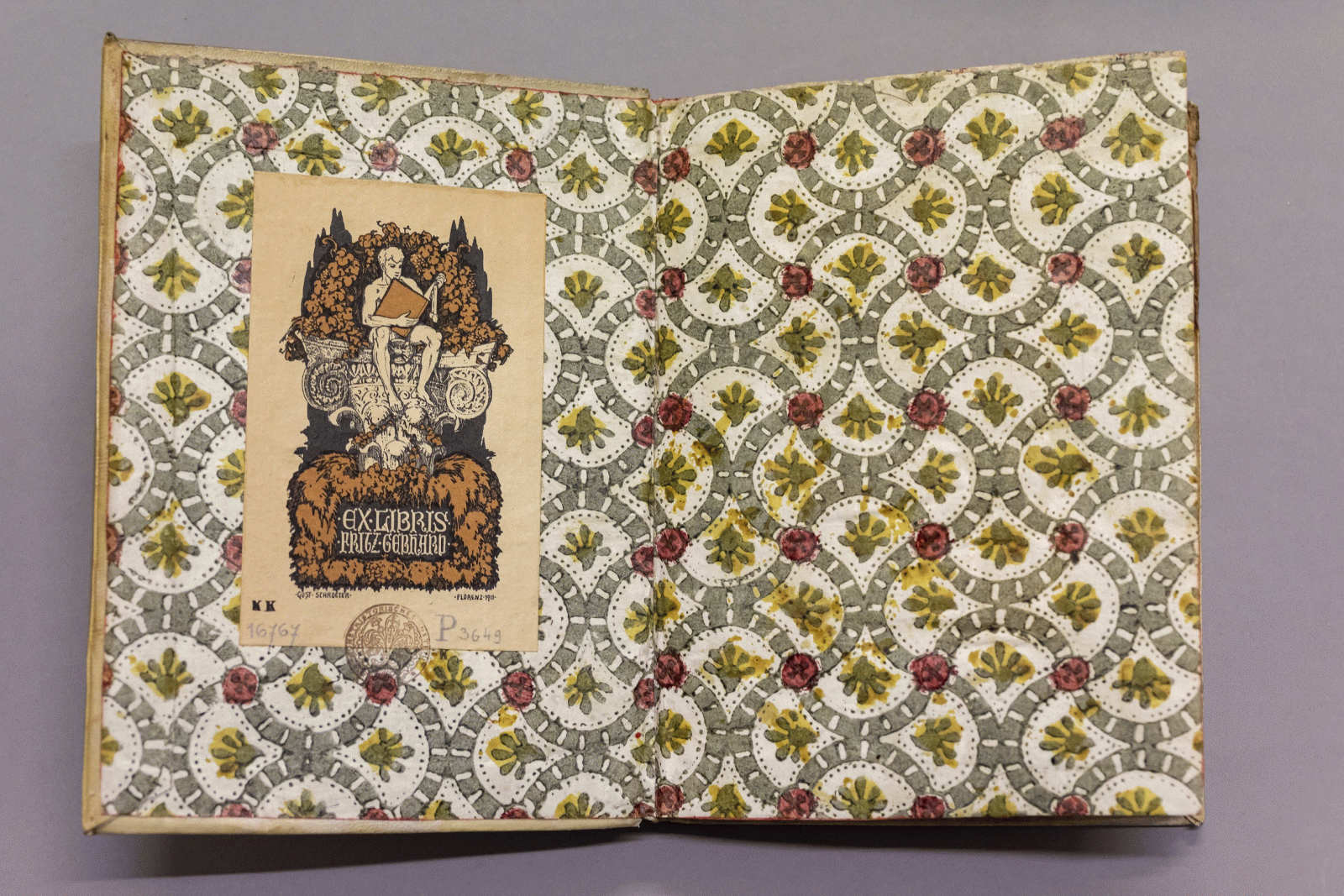
Bertinazzi, Bologna, late 18th century, the pattern was also printed by other firms.
Torello Sarayna, Le historie e fatti de‘ Veronesi ne i tempi del popolo e Signori Scaligeri, descritte dall’eccellentissimo dottor Torello Saraina veronese […], Verona 1586.
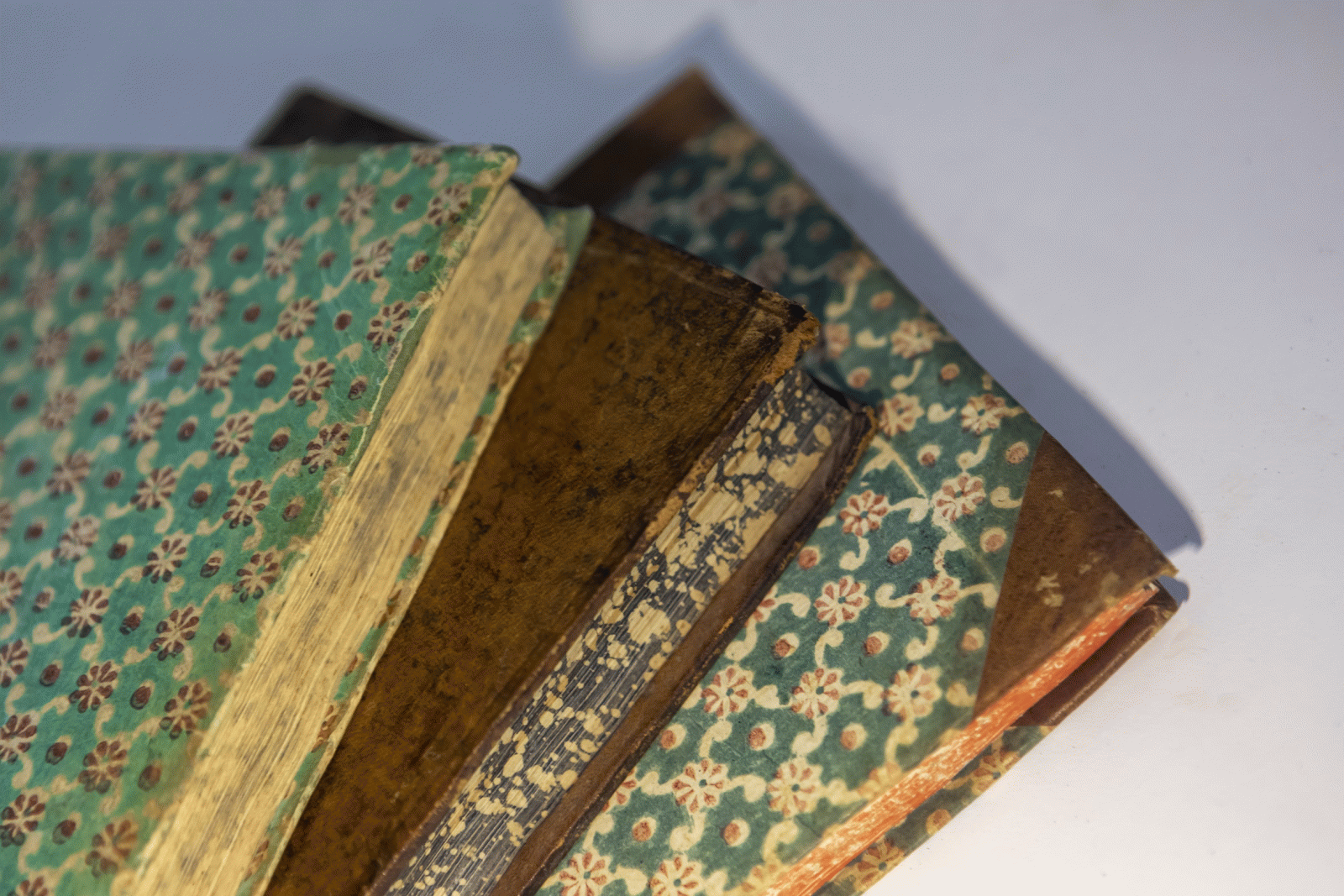
Bertinazzi, Bologna, late 18th century.
Caesariensis Basilius, Omelie Scelte di S. Basilio Magno / Tradotte Dal Greco Nell’Idioma Toscano Da Angiol Maria Ricci Lettore Di Lettere Greche Nello Studio Fiorentino, Firenze 1732.
Juan Interián de Ayala, El pintor christiano, y erudito, ó tratado de los errores, que suelen cometerse frequentemente en pintar, y esculpir las Imágenes Sagradas […], Madrid 1782.
Bartolomeo Moirani, Vita della Beate Maria Dell’Incarnazione Monaca Conversa Professa Dell’Ordine Delle Carmelitane Scalze, E Fondatrice Del Medesimo Ordine In Francia, Venezia 1791.
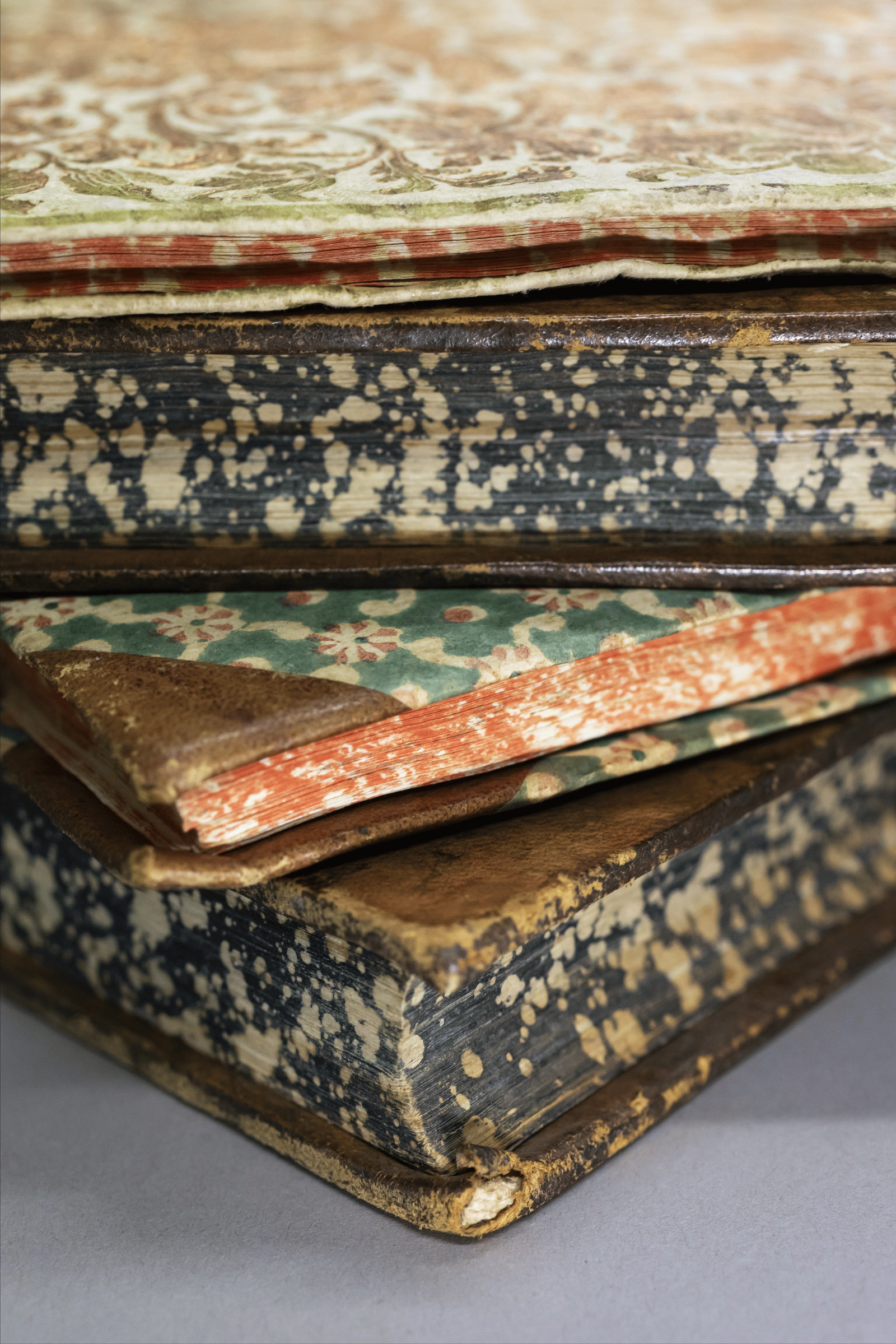
Brocade paper, gold coloured on white paper and Bertinazzi, Bologna, late 18th century.
La distribuzione dei premj solennizzata sul Campidoglio li 4. Iuglio 1805: dall’insigne Accademia delle Belle Arti Pittura, Scultura e Architettura in S. Luca, Roma 1806.
Juan Interián de Ayala, El pintor christiano, y erudito, ó tratado de los errores, que suelen cometerse frequentemente en pintar, y esculpir las Imágenes Sagradas […], Madrid 1782.
Bartolomeo Moirani, Vita della Beate Maria Dell’Incarnazione Monaca Conversa Professa Dell’Ordine Delle Carmelitane Scalze, E Fondatrice Del Medesimo Ordine In Francia, Venezia 1791.
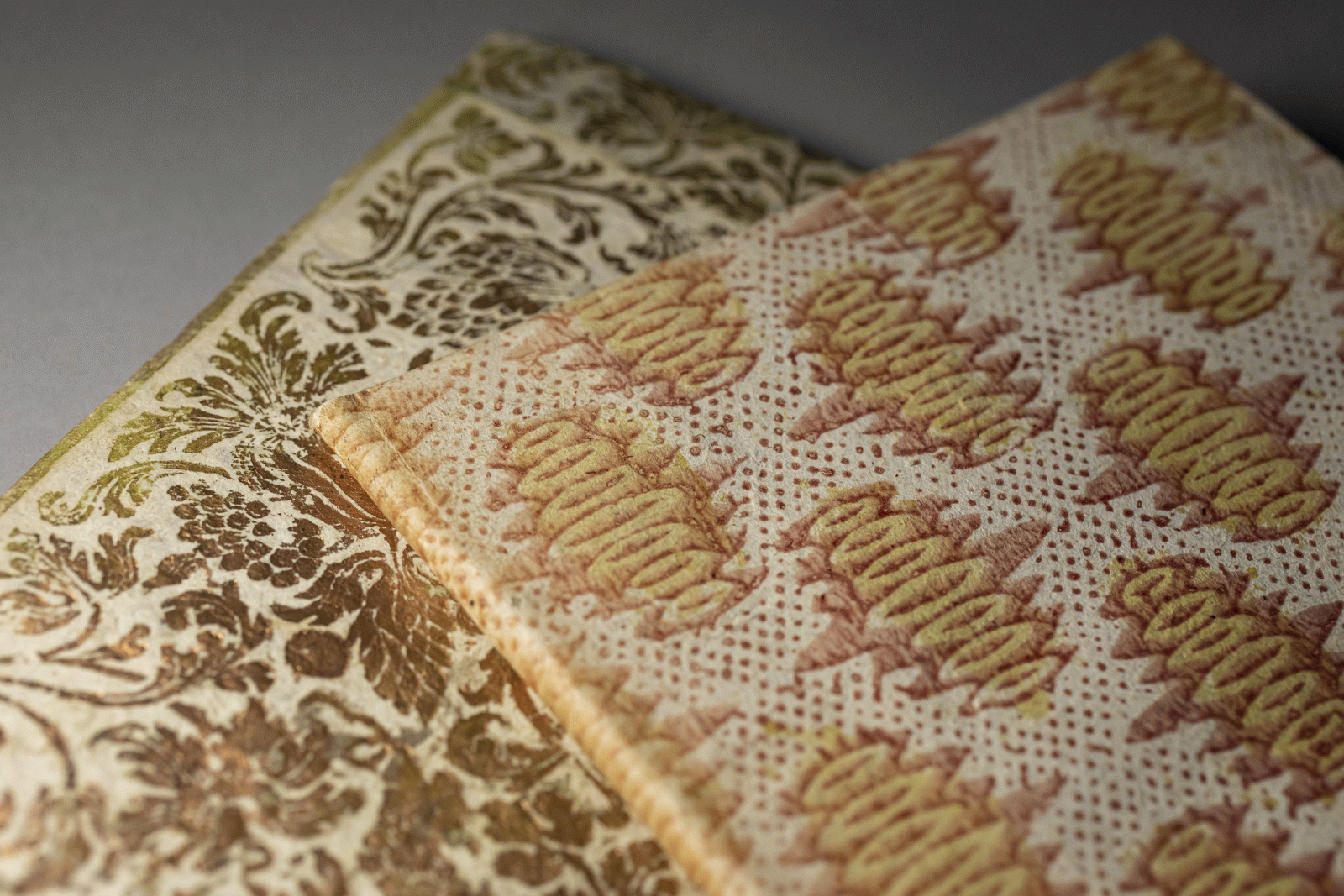
Brocade paper, gold coloured on white paper and Remondini paper, 2nd half of the 18th century.
La distribuzione dei premj solennizzata sul Campidoglio li 4. Iuglio 1805: dall’insigne Accademia delle Belle Arti Pittura, Scultura e Architettura in S. Luca, Roma 1806.
Michelangelo Sermartelli, Descrizione delle pompe e delle feste fatte nella venuta alla città di Firenze del sereniss. Don Vincenzio Gonzaga, principe di Mantova e del Monferrato, per la serenissima D. Leonora de Medici, principessa di Toscana sua consorte, Firenze 1584.
Successful patterns were varied over a long period of time and often copied in poorer quality by other manufacturers. When publishers' bindings became increasingly popular from the 19th century onwards, coloured papers, especially marbled papers, were reproduced using modern printing techniques and used as endpapers or covers. Unfortunately, the fragile historical papers often show their age. Almost all of them show signs of use, discolouration and damage.
Further examples of coloured papers can be found in the database Digital Libraries Connected, Kunsthistorisches Institut in Florenz, by using the search field Metadata and entering the search term "Buntpapier".
Photography: Bärbel Reinhard (Fondazione Studio Marangoni)
Concept and Coordination: Library, Research Coordination and Public Relations in collaboration with Ingeborg Bähr
Text: Ingeborg Bähr



